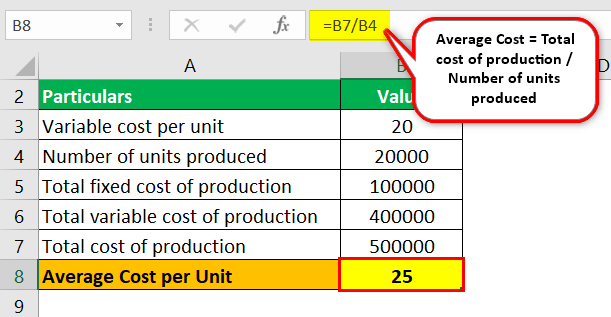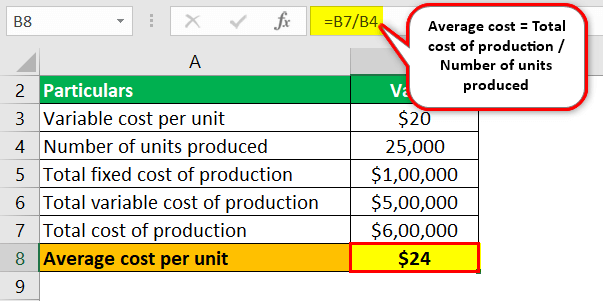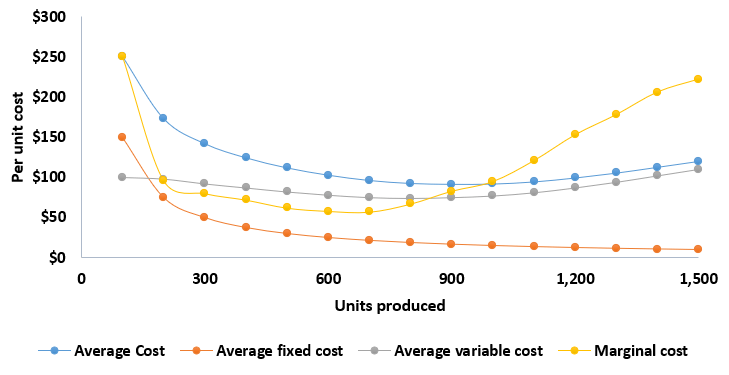How To Calculate Long Run Average Total Cost
What is the Boilerplate Cost?
Boilerplate cost refers to the per-unit of measurement price of production, which is calculated past dividing the total cost of product by the total number of units produced. In other words, it measures the amount of money that the business has to spend to produce each unit of measurement of output. It forms a fundamental component of demand and supply as it affects the supply curve.
It is also known equally unit cost or average total price. We can farther break downwards the total cost of production into fixed and variable cost components. Mostly, the full stock-still toll Fixed Cost refers to the cost or expense that is non afflicted past any decrease or increment in the number of units produced or sold over a short-term horizon. It is the type of cost which is non dependent on the business organisation action. read more component doesn't alter, and hence the change in average cost is primarily due to a alter in total variable cost Full variable toll is the total of all variable costs that would change in proportion to the output or the product of units and helps analyze the company's overall costing and profitability. Full variable toll formula = number of units produced 10 variable toll per unit of measurement. read more . If the cost reaches the threshold, then it is advisable to either increase the selling price or negotiate the variable cost component, equally otherwise, information technology will result in business loss.
How to Calculate Average Toll?

You are complimentary to utilize this image on your website, templates etc, Delight provide us with an attribution link Article Link to be Hyperlinked
For eg:
Source: Average Toll (wallstreetmojo.com)
We can calculate it by following these five steps:
Step ane: Firstly, determine the stock-still cost of product incurred during the given period, which may include bacon, depreciation Depreciation is a systematic allocation method used to account for the costs of whatever physical or tangible asset throughout its useful life. Its value indicates how much of an asset'southward worth has been utilized. Depreciation enables companies to generate revenue from their assets while only charging a fraction of the cost of the asset in use each year. read more & amortisation Acquittal of Intangible Avails refers to the method past which the cost of the company'due south various intangible assets (such equally trademarks, goodwill, and patents) is expensed over a specific time period. This fourth dimension frame is typically the expected life of the asset. read more , lease rental, marketing & advertising expenses, etc. These cost heads don't change with the change in production volume.
Footstep ii: Next, determine the variable cost of product incurred during the given period, which may include the price of raw fabric, wages, electricity bill, etc. These cost heads are mainly dependent on the production volume.
Step 3: Adjacent, calculate the total cost of product Production Cost is the full capital amount that a Company spends in producing finished appurtenances or offering specific services. Y'all can calculate it by adding Direct Fabric cost, Direct Labor Cost, & Manufacturing Overhead Cost. read more than by calculation upward fixed (footstep 1) and variable cost of production (step 2).
Full Cost of Production = Fixed Cost of Product + Variable Cost of Production
Footstep 4: At present, determine the number of units produced during the given catamenia.
Step 5: Finally, calculate the average cost of production by dividing the total toll of product (footstep 3) by the number of units produced (step 4) as shown beneath.
Boilerplate Toll Formula = Total Toll of Production / Number of Units Produced
Examples
You tin download this Average Cost Excel Template here – Average Cost Excel Template
Example #1
Let u.s. take the simple example of the manufacturing plant of ASF Inc., where the full stock-still cost of production during the year was $100,000, and the variable cost of product was $20 per unit. Make up one's mind the boilerplate toll of production if the company manufactured twenty,000 units during the year.
Given,
- Variable cost per unit of measurement = $20
- Number of units produced = 20,000
- Total stock-still cost of production = $100,000
Solution:
Calculation of Full variable cost of production will be –
The full variable cost of production = Variable cost per unit * Number of units produced

Full variable cost of production = $20 * twenty,000 = $400,000
Now, the adding of the total cost of production is every bit follows:
Total cost of product = Total fixed cost + Total variable price

Full cost of product = $100,000 + $400,000 = $500,000
At present, the adding is equally follows:
Average price Formula = Total toll of product / Number of units produced

= $500,000 / xx,000 = $25 per unit
Instance #2
If in the above instance the number of units produced during the year increased to 25,000, so decide the average toll of production for the increased product.
Given,
- Variable cost per unit = $twenty
- Number of units produced = 25,000
- Total fixed cost of production = $100,000
Solution:
The adding of the total variable cost of production will be –
The full variable cost of production = Variable cost per unit * Number of units produced

The full variable cost of production = $xx * 25,000 = $500,000
Now, the calculation of the total price of production is as follows:
Full cost of production = Total fixed cost + Full variable toll

Total cost of production = $100,000 + $500,000 = $600,000
Now, the adding is equally follows:
Average Toll Formula = Total cost of production / Number of units produced

= $600,000 / 25,000
= $24 per unit of measurement
Therefore, the new unit cost of product reduced from $25 to $24 per unit of measurement owing to the benefits of economies of scale Economies of scale are the cost advantage a concern achieves due to big-scale production and higher efficiency. read more .
Average Toll Diagram
Typically, the average cost bend (blue line) results in a U-shape as tin be seen in the above diagram. It is primarily because of the average variable cost of production (grey line) that decreases with the increase in production initially and then starts increasing with the incremental production. On the other hand, the average fixed costs (orangish line) go along to subtract significantly every bit the product volume increases.

The marginal cost Marginal cost formula helps in computing the value of increment or subtract of the full product price of the visitor during the period under consideration if there is a alter in output by one extra unit. It is calculated by dividing the change in the costs by the change in quantity. read more (xanthous line) after initial decrease starts to increment due to diminishing marginal productivity and it intersects the curve at its lowest betoken (minimum), afterward which the curve also starts to slope upwardly. From this point onwards, the marginal cost curve is above the average cost curve, and hence an increase in production volume increases cost.
This concept is critical equally information technology helps in determining the long-run price and supply of any article, and hence it influences profit significantly. For instance, if the selling price of a commodity is higher than its boilerplate cost (Air conditioning), then the company makes a profit. On the other hand, if the selling cost is lower than the unit cost, and then information technology is a loss-making proposition.
Advantages
- It considerably simplifies the procedure of cost calculation and tape keeping.
- Information technology automatically adjusts the touch on of price volatility witnessed during the given period.
- Information technology makes manipulation of accounting figures difficult and hence provides an accurate picture of the business.
Disadvantages
- Every time a new purchase happens at a charge per unit different than the previous ane, information technology changes, resulting in frequent changes in selling cost equally well.
- The boilerplate price may non exist reflective of the prevailing market charge per unit as it averages out the price across the menstruation.
Recommended Manufactures
This article has been a guide on what is the average cost and its definition. Here we discuss how to calculate information technology along with applied examples. You can learn more than almost accounting from the post-obit articles –
- Average Total Cost Formula
- Unit Price
- Boilerplate Variable Cost
- Average Fixed Cost
Source: https://www.wallstreetmojo.com/average-cost/
Posted by: langfordcounce.blogspot.com


0 Response to "How To Calculate Long Run Average Total Cost"
Post a Comment